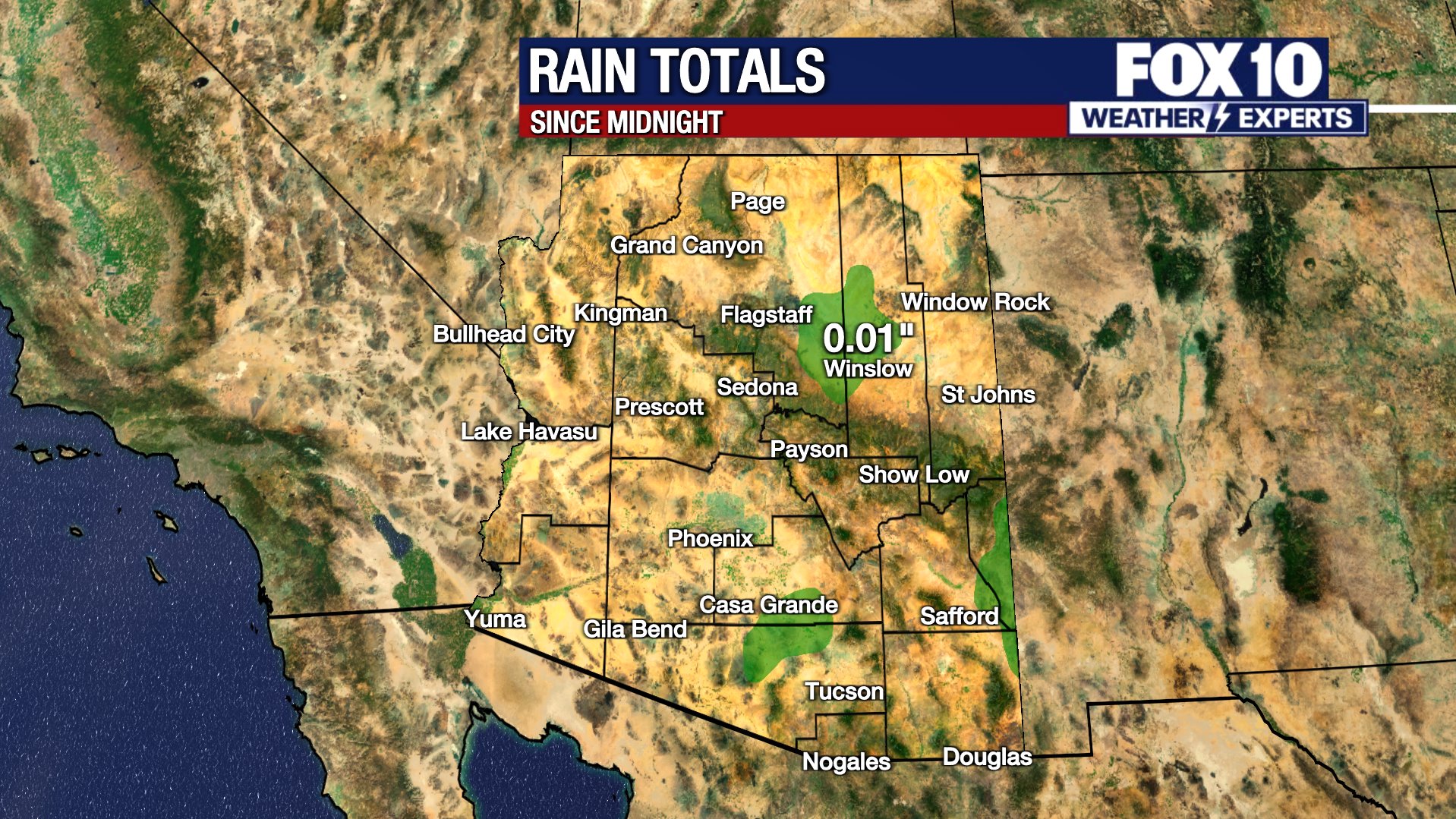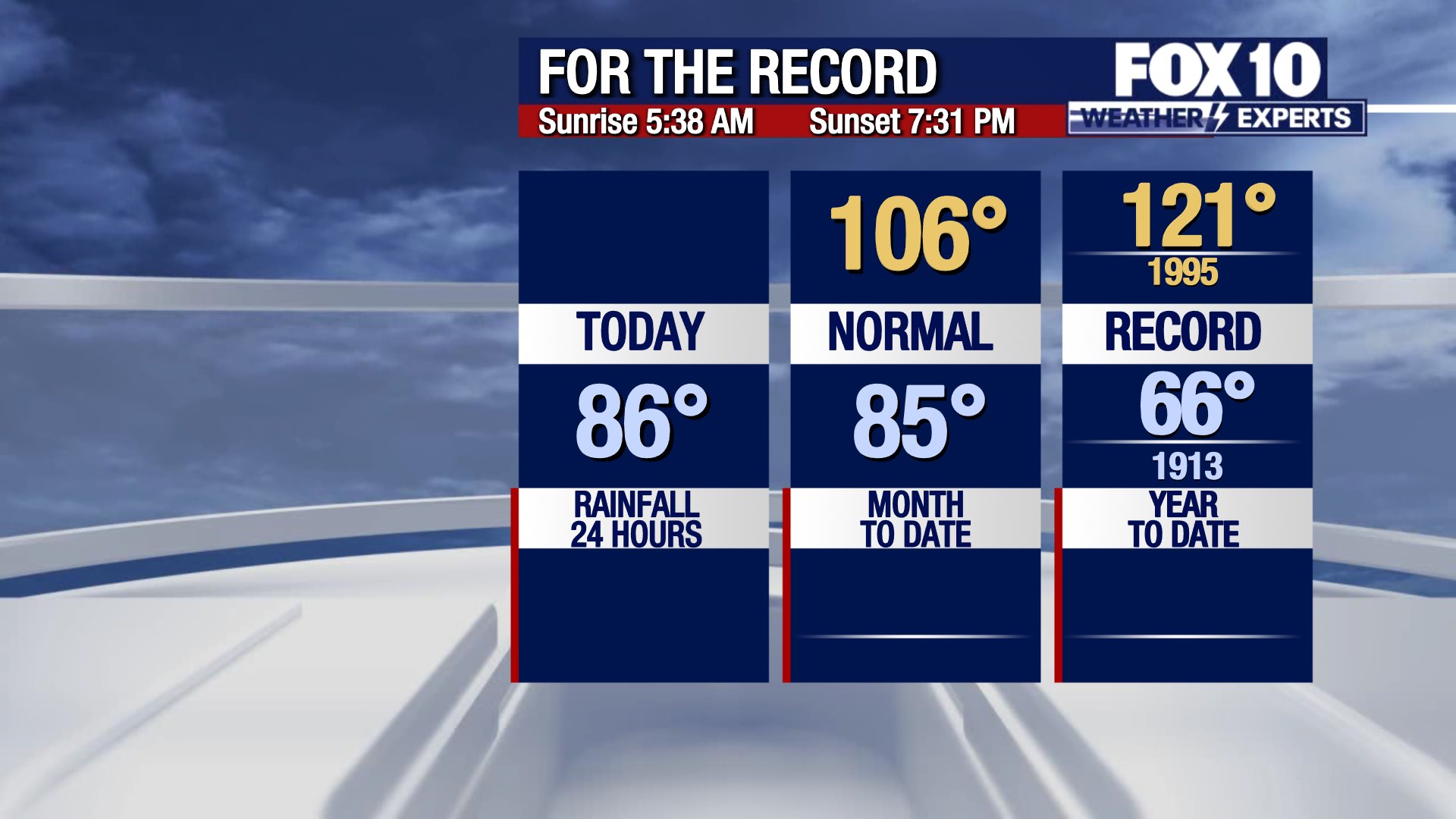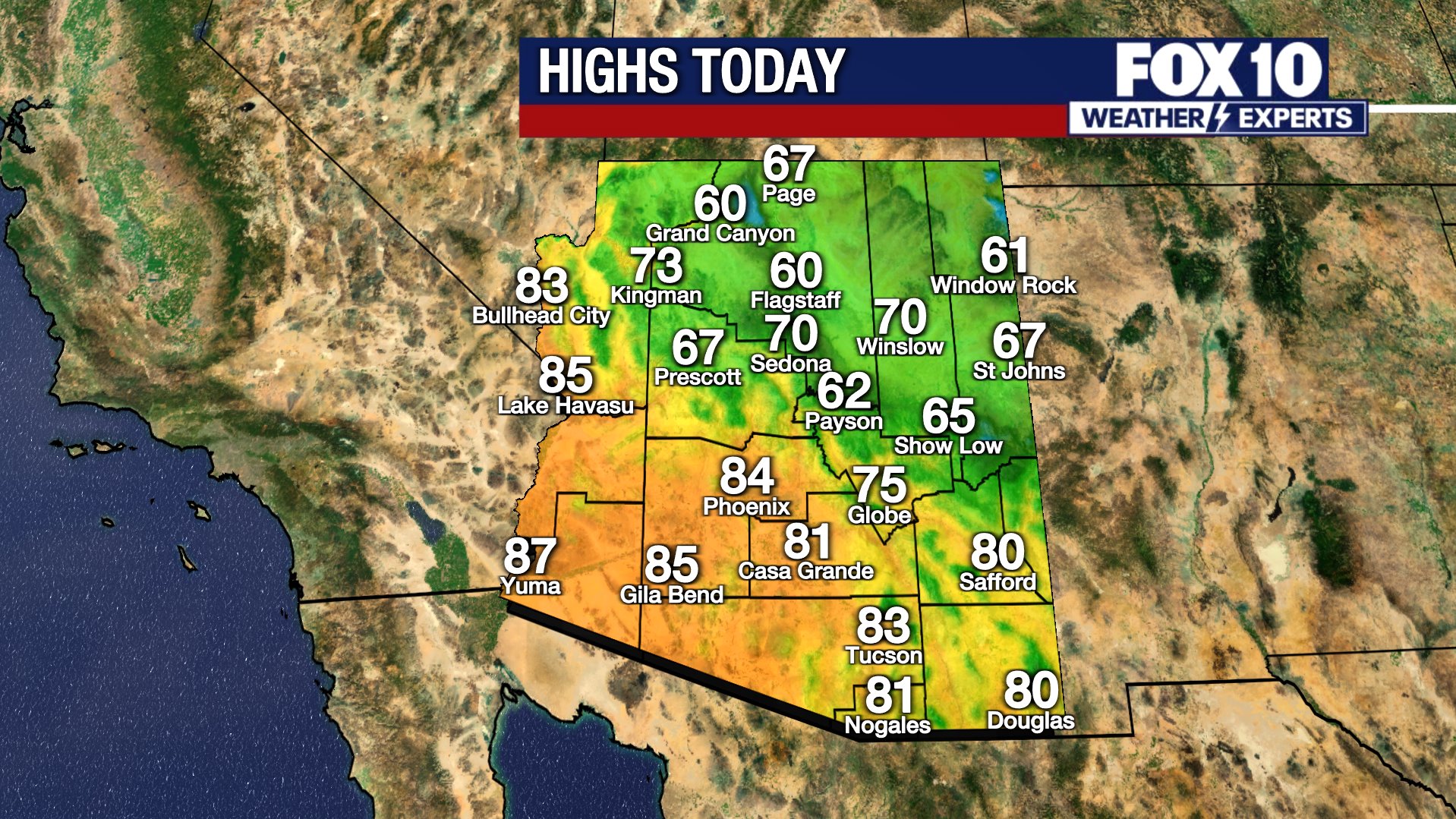Arizona weather forecast: 110s in the forecast for the rest of the week in Phoenix
PHOENIX - Forecasters with the National Weather Service say parts of the state could see some storm activity.
"Gusty thunderstorm outflow winds and patchy blowing dust will continue to be the most widespread concerns today, with locally heavy rain over the high terrain," read a portion of the forecast.
The chance for rain, according to NWS, ranges from 60% in Flagstaff to 12% in the Phoenix area. That could increase as the week goes on.
"By the latter half of the week, there will be increasing chances for more widespread activity, including for the lower deserts," read a portion of the forecast. "The best chances for lower desert storms across South-Central Arizona begins on Sunday, with around a 40% chance of measurable rainfall each day into early next week for downtown Phoenix."
In terms of temperatures, Phoenix is expected to see temperatures in the 110s for the rest of the week, ranging from a high of 111°F on Tuesday to 115°F on Saturday.
Southern Arizona
Forecasters with the NWS in Tucson say there is a chance for stormy weather in various parts of southern and southeastern Arizona.
"Expect scattered showers and thunderstorms today with the best chances in Santa Cruz and Cochise Counties as well as in the White Mountains," read a portion of the forecast. "Heavy rainfall leading to flash flooding and strong outflow winds will be the main threats. Some storms could be severe."
Meanwhile, forecasts are calling for a high of 114°F on Friday and 115°F on Saturday in Yuma.
You can always check the latest weather conditions by visiting the FOX 10 Phoenix weather page, or download the Free FOX 10 Weather app, which is available on Apple iOS and Android.
Scroll down this page for satellite and radar, day planner, records, current temperatures, 10-day forecast, forecast highs, and recent rainfall totals, plus live video feeds.

The following heat safety information was provided by the Scottsdale Fire Department.
What are Heat Emergencies?
Heat Cramps: Profuse sweating, fatigue, extreme thirst, muscle cramps
Heat Exhaustion: Headache, dizziness, weakness, nausea/vomit, Cool/moist skin
Heat Stroke: Elevated temp. +103degrees, confusion/irrational behavior, dry/hot skin, rapid shallow breathing, rapid weak pulse (shock), seizures, unconscious
What to do
- Get person into shade or cool location
- Cool person with cool, wet cloths (neck, groin, armpits, head) and fan body
- Sip cool water if person is alert
- For muscle cramps, massage muscles gently, but firmly until relaxed
- *If symptoms worsen, call 911
What not to do
- Do not give anything by mouth if person is vomiting, unable to swallow or unconscious
- Do not underestimate the seriousness of a heat emergency
- Prevention/Preparation for hike/exercise in heat
Know your limitations
- Hydrate (begins day prior to hike/exercise, hour before hike, during and after)
- Wear proper clothing, lightweight and light color, protect head, proper shoes
- Always carry a cell phone and best to hike with company
- Always tell someone where you are hiking and when to plan to return
Preventing heat exhaustion/heat stroke
The Arizona Department of Health Services stated the following precautions can be taken to prevent heat exhaustion or heat stroke:
- Stay in air-conditioned buildings
- Find a cooling center/hydration station
- Limit outdoor activity during the hottest part of the day (mid-day)
- Check on at-risk friends, family, and neighbors at least twice a day
- Drink water before, during, and after working or exercising outside
- Check the UV Index
- Check the heat risk map
Driving in extreme temperatures
The Arizona Department of Transportation’s tips for driving in extreme temperatures include:
Have sun protection: In addition to an umbrella, take sunscreen and a wide-brimmed hat and wear loose-fitting, light-colored cotton clothing.
Fuel up: Keep your tank at three-quarters full. Running out of gas, especially in a remote location, is dangerous in extreme heat.
Hydrate: Take a cooler to keep extra drinking water cold, and consider adding several frozen bottles of water to use for cooling off or to thaw and drink if needed. Make sure everyone, including pets, stays hydrated.
Get help: If your vehicle breaks down in extreme heat, call for assistance right away to reduce wait time, and run the AC. If the AC isn’t working, roll down all windows.
Wait safely: If the temperature inside your vehicle becomes too hot, everyone, including pets, should exit carefully and seek out or create a shaded area as far away from the travel lanes as possible. Be careful walking on the road surface, which can be hot enough to burn skin. Keep your shoes on and try to keep your pets’ paws off the pavement. If you are stopped along the highway, raise the front hood and turn on hazard lights. Please keep in mind that parking in tall brush can start a fire.
Check your vehicle: You can help avoid breakdowns and blowouts by making sure your vehicle is in good operating condition. Check your air conditioner and coolant levels, top off any vital engine fluids and make sure your battery is up to par. Check your tire pressure, as the combination of under inflated tires and hot pavement can lead to a blowout.
Preparing for a severe thunderstorm
The American Red Cross' tips for preparing for a severe thunderstorm:
- Put together an emergency kit.
- Know your community’s evacuation plan.
- Create a household disaster plan and practice it.
- Purchase a battery-powered or hand-crank radio
- Discuss thunderstorm safety with members of your household. Be aware that a thunderstorm could produce flooding.
- Pick a safe place in your home for household members to gather during a thunderstorm. This should be a place where there are no windows, skylights, or glass doors, which could be broken by strong winds or hail and cause damage or injury.
Be prepared and stay safe during the monsoon
"Most Valley residents know how quickly and furiously storms can move in and out, bringing strong winds, dust, rain, and flash flooding. These storms can cause interruptions in services, such as water, power, and gas," stated Captain Ashley Losch of the Glendale Fire Department.
GFD reminds residents of ways they can be prepared and stay safe:
- Have flashlights with extra batteries on hand.
- Have food that can be prepared without the need for cooking or refrigeration.
- Have at least one gallon of clean water for each person in the household.
- Have backup power for anyone requiring power for a medical device.
- Have backup power for cell phones that do not require charging.
- Have a first aid kit ready and accessible.
- Never drive into areas with flowing water; it takes less than 10 inches to wash a car away.
- Avoid flooded areas, such as washes.
- If waters are rising, seek higher ground.
- Do not approach downed power lines, the ground can be energized for up to 200 feet.
- Keep pets indoors during storms.
MORE: https://azdot.gov/about/transportation-safety/severe-weather








